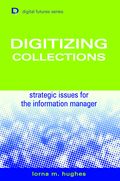 |
| About IR |
| Editors |
| Author instructions |
| Copyright |
| Author index |
| Subject index |
| Search |
| Reviews |
| Register |
| Home |
Hughes, Lorna M. Digitizing collections: strategic issues for the information manager. London: Facet Publishing, 2004. xvi, 327 p. (Digital Future Series). ISBN 1 85604 466 1. £39.95.
In the Introduction to the book Lorna Hughes (Assistant Director for Humanities Computing, Information Technology Services at New York University) stresses that she was mainly concerned about "what staff in memory institutions need to know about the strategies and practical issues involved in putting digital collections of cultural materials online" (p.xi.). The target audience for the publication are librarians, archivists, museum professionals, and the students of respective subjects. The author covers a wide range of issues of digitisation and developing digitized collections. In the first part she introduces basic strategic concerns, like goals of digitising collections, choosing criteria for selection of materials for digitisation, taking into account copyright problems, cost-benefit issues, building collaborating groups, and developing staff resources. The second part is devoted to practical implementation of digitisation projects.
The highlight of the first part is mainly on various aspects of risk calculation, including a very relevant section "When it is advisable not to digitize?" (p. 49-52), which also enumerates wrong motives of digitization. The readers should read closely all sections about estimating costs and other financial matters that are embedded in most of the chapters in both parts of the book. One can hope that this approach has its effect on long-term planning of the resources whenever new digitization projects are undertaken. The chapter on intellectual property and other legal issues is quite extensive and emphasises the main threats from the point of view of digitising various materials (especially those under copyright protection). However, I would like to challenge the implication that the copyright protection should be strengthened and extended in the digital environment. It is an increasingly problematic issue and technical vulnerability of copyrighted material is just a minor item within a major discussion. Maybe the time to consider alternative ways of compensation for authors and producers of intellectual property on international level is closer than we expect. On the other hand, the section about potentially sensitive materials has introduced not only the issues of privacy or data protection but also culturally sensitive content and necessity to respect these sensitivities. These concerns are rarely taken into account in digitisation literature. Within the chapter on the importance of collaboration various allies and frameworks for co-operation are considered. Maybe the need at least to inform a wider public if not to involve it into the long-term projects might be stressed more emphatically. It could help to avoid negative publicity as in the case of New York Public Library, which is shortly addressed in the second part of the book (p. 210).
The second part of the book is a detailed account of main stages of project implementation: finding funds for digital collections, application of technology, standards and formats, metadata, quality control, training, work organisation and methods. Each item is reflected in relation to digitising of a certain type of material: rare and fragile items, audio and moving image collections, texts and images. The clear statement that digitised collections are not meant to preserve the material is very important. Most professionals know that the age of digital materials is limited. However, digitisation diminishes the actual handling of originals and this indirect preservation effect often mentioned in the projects might raise unfounded expectations of funders or other non-professional stakeholders. The structure of the book is transparent. The case studies throughout the text provide real-life illustrations and also might be useful as data about organisations and individuals with relevant competence and expertise for the beginners. Though American cases and literature in the extensive bibliography dominate, the author also uses British and Scandinavian publications, cases and internet resources. Hopefully the latter will not change the URLs very quickly. A subject index at the end of the book supplies a feature that enhances the reference function of the book.
The author has achieved the main goal and provided an extensive overview of strategic and practical issues related to digitising of cultural heritage. It is a valuable aid to librarians, archivists and museum workers. At the same time this publication may be useful to other users who are struggling with digitisation problems.
Marija Norvaisaite
Faculty of Communication
Vilnius University, Lithuania
March 2004
How to cite this review
(2004) Review of: Hughes, Lorna M. Digitizing collections: strategic issues for the information manager. London: Facet Publishing, 2004. Information Research, 9(3), review no. R135 [Available at: http://informationr.net/ir/reviews/revs135.html]